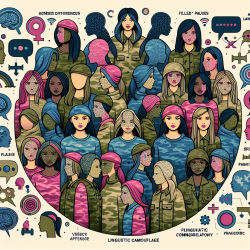Introduction
Autism Spectrum Disorder (ASD) is a complex neurodevelopmental condition that presents unique challenges in diagnosis and intervention, particularly for girls. Recent research highlights the phenomenon of "linguistic camouflage" in girls with ASD, where their speech patterns may appear typical, masking underlying social communication difficulties. Understanding these nuances is crucial for speech-language pathologists aiming to provide effective support and interventions.
Understanding Linguistic Camouflage
The study "Linguistic camouflage in girls with autism spectrum disorder" sheds light on how girls with ASD may use filled pauses such as "um" and "uh" differently compared to boys. This difference can serve as a linguistic camouflage, making their speech sound more typical to a naïve listener. The study found that girls with ASD tend to use "um" more frequently than "uh," aligning with typical female speech patterns, which can obscure the detection of ASD symptoms.
Implications for Practitioners
For practitioners, recognizing these subtle linguistic markers is essential. Here are some strategies to improve diagnostic accuracy and intervention outcomes:
- Enhanced Assessment Techniques: Incorporate detailed analysis of speech disfluencies in assessments. Pay attention to the frequency and type of filled pauses used by girls during conversational tasks.
- Gender-Sensitive Diagnostic Tools: Utilize diagnostic tools that account for gender differences in speech patterns. This can help in identifying girls who might otherwise be overlooked or misdiagnosed.
- Training and Awareness: Educate clinicians and educators about the concept of linguistic camouflage. Understanding these differences can lead to more informed observations and referrals.
- Individualized Intervention Plans: Develop intervention strategies that address the unique communication styles of girls with ASD. Focus on enhancing pragmatic language skills while considering their natural speech patterns.
Encouraging Further Research
While this study provides valuable insights, it also highlights the need for further research. Expanding the sample size and including diverse populations can enhance our understanding of linguistic camouflage and its implications. Moreover, exploring the impact of cultural and socio-economic factors on speech patterns can provide a more comprehensive view.
Conclusion
Recognizing linguistic camouflage in girls with ASD is a step towards more accurate diagnoses and effective interventions. By integrating these findings into practice, speech-language pathologists can contribute to better outcomes for children with ASD. For those interested in delving deeper into this topic, I encourage you to read the original research paper, Linguistic camouflage in girls with autism spectrum disorder.










